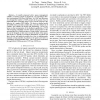Free Online Productivity Tools
i2Speak
i2Symbol
i2OCR
iTex2Img
iWeb2Print
iWeb2Shot
i2Type
iPdf2Split
iPdf2Merge
i2Bopomofo
i2Arabic
i2Style
i2Image
i2PDF
iLatex2Rtf
Sci2ools
INFOCOM
2003
IEEE
2003
IEEE
Understanding CHOKe
— A recently proposed active queue management, CHOKe, is stateless, simple to implement, yet surprisingly effective in protecting TCP from UDP flows. As UDP rate increases, even though the number of UDP packets in the queue rises, its bandwidth share eventually drops to zero, in stark contrast to the behavior of a regular FIFO buffer. We derive a detailed model of CHOKe that accurately predicts this, and other behaviors of CHOKe, and validate the model with simulations. Its key features are the incorporation of the feedback equilibrium of TCP with dropping probability and the spatial characteristics of the queueing process. CHOKe produces a “leaky buffer” where packets can be dropped as they move toward the head of the queue. This leads to a spatially non-uniform distribution of packets and their velocity, and makes it possible for a flow to simultaneously maintain a large number of packets in the queue and receive a vanishingly small bandwidth share. This is the main mechanism...
| Added | 04 Jul 2010 |
| Updated | 04 Jul 2010 |
| Type | Conference |
| Year | 2003 |
| Where | INFOCOM |
| Authors | Ao Tang, Jiantao Wang, Steven H. Low |
Comments (0)

